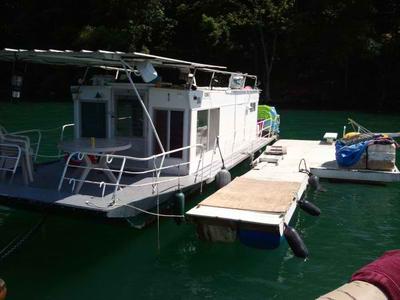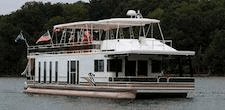Grab your free gift, our online Houseboat Magazine, when you sign up!

A rare 1969 Leisure Craft houseboat
by Sandra in Tennessee
I have purchased a 1969 " drifter style " houseboat. She is a Leisure Craft. The name plate includes "Jising Houseboats by James E. Cron , Gallatin TN."
She is moored without shore power and I don't know if there is a bilge pump in the forward section of the hull. I can access the hull at the stern where the motor is located.
The forward section I cannot locate an opening to access it? The stairs at the bow slides out, however that whole section is a storage area with no way to get beneath it.
There doesn't seem to be an access in the head for the hull either. The wiring from the wheel has been "augmented".
Someone has carpeted over the original vinyl, and short of tearing all the carpeting out, I'd rather yell HELP !
Does someone out there know where I can access the hull's bottom for a new 12v bilge pump install? ANY information on this boat / builder / an owners manual / research links - would be so greatly appreciated.
Thanks, Sandra in TN.
 increase sales and profits with targeted traffic? Act now to get our 1/2 price sale, limited offer |
Reply - Answer
Well Sandra, congratulations on your purchase and I am sure that slowly but surely, all your questions and issues will work out.
In regards to accessing the forward bilge area on your Leisure Craft, I am not sure where the access panel is, OR if you will have to create a new opening.
I'm sure that someone who is very familiar with this extremely rare model will be replying shortly with more detailed information.
Lastly, hopefully some of our readers and visitors will share and post comments about any LeisureCraft houseboat experiences and tips.
Feel free to use the "Click here to post comments." link found near the bottom of this page.
Thanks again for sharing, IAN from all-about-houseboats
More Information
Free Bonus Offer |
Comments for A rare 1969 Leisure Craft houseboat
|
||
|
||
|
||
|
||
|
||
|
||
|
||
|
||
|
||
|
||
|
||
|
||
|
||
|
||
|
||














